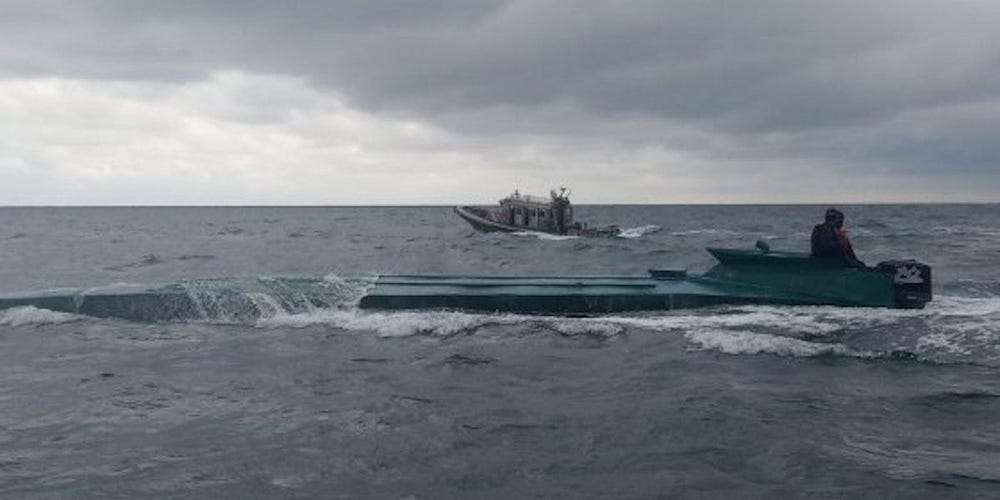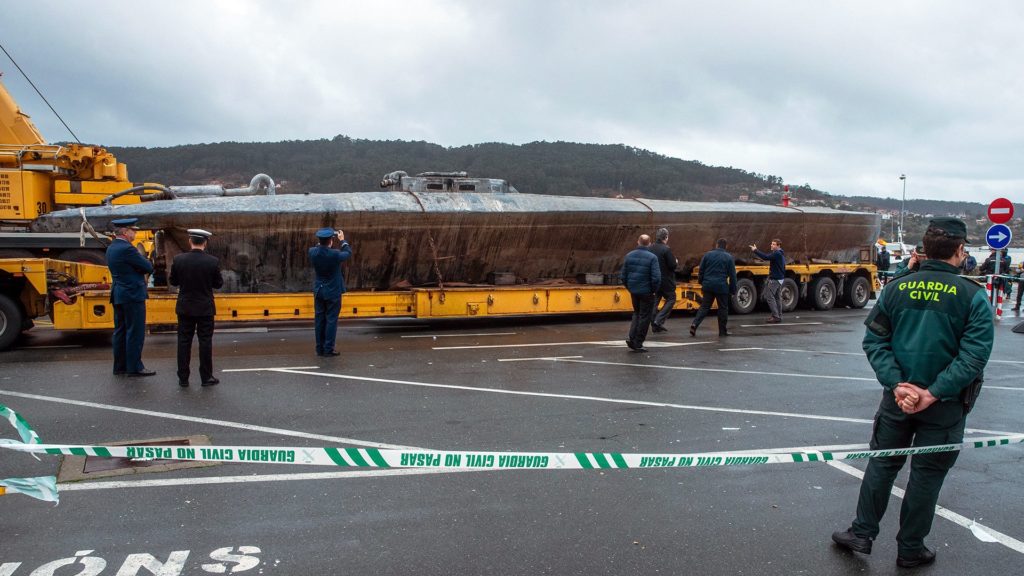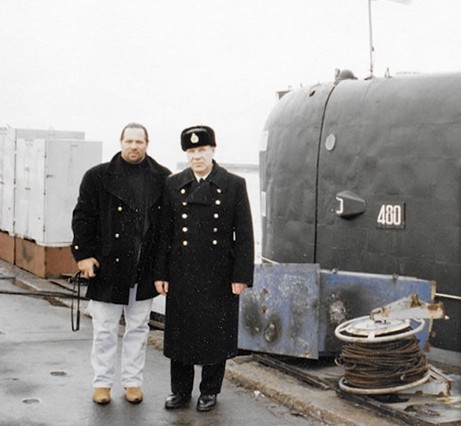Narco subs
In the last few months, an increasing number of so-called narco subs, also called drug subs, have been intercepted in international waters by law enforcement (“LE“). A narco sub is usually a self-propelled semi-submersible (“SPSS“) used by drug traffickers to transport large quantities of illegal drugs for cartels to an international market.
SPSS are stealthy and often go unnoticed and have grown in popularity so much that US officials now estimate that more than 30% of cocaine trafficked into the US enters from SPSSs. Many SPSSs are self-driving.
Security concerns
Of concern for international security is the risk that such vessels may be used by terrorists or agents engaged in state-sponsored terrorism to transport weapons of mass destruction undetected, or to attack the US or Canadian coast along the Pacific Ocean. Terrorist organizations and drug cartels already have existing trade and money laundering relationships.
More sophisticated narco subs
In August 2020, a 100 foot narco sub was found by LE in Colombia in a river in the jungle, which if operational, could carry about US$200 million in cocaine.
A few days after that discovery, Colombian LE seized a SPSS carrying US$18.2 million of cocaine being transported for Mexico’s leading cartel, the Jalisco New Generation Cartel (“CJNG“). Colombian LE believe the SPSS is owned by the CJNG.

On a small scale, a small personal submersible was used by a Canadian in a kind of a James Bond move to smuggle cash and 265 pounds of illegal drugs under the Detroit River from Canada to the US in June, 2020. The personal submersible was equipped with two cameras, wifi and could operate at more than 13 miles per hour. It is the first known case of a personal submersible being used underwater to smuggle drugs between Canada and the US.
They pale in comparison, however, to the November 2019, detection and seizure of a 66 foot submarine captured off Spain transporting US$100 million in cocaine from Colombia that has transited through a third country, likely Brazil and crossed the Atlantic Ocean.

Connections to Canada
The formation of the idea of Colombian and Mexican drug cartels using submarines to transport illegal drugs across borders is not new. The idea originated in the early 1990s and has some connections to Canada.
Here’s how.
A Russian submarine for Cali Cartel
Three people in Miami – a Russian mobster named Ludwig “Tarzan” Fainberg who had immigrated to the US, a fugitive Cuban drug trafficker named Nelson “Tony” Yester, and drug trafficker and supplier of luxury vehicles, “go fast” drug boats and equipment to drug cartels named Juan Almeida – offered to obtain a Russian submarine for the Cali Cartel. The idea was that the Cali Cartel would use submarines to more efficiently and economically transport narcotics to Canada and the US. They figured that in one trip, they could move 40 tons of narcotics up the Pacific Coast to Canada or the US without detection.
The three wise guys traveled to Russia to inspect submarines. They were able to gain permission to access a restricted Russian naval base and even to take pictures with their own phones of the naval base. They entered into negotiations to buy one submarine from the Russian government for US$35 million.
The Cali Cartel paid millions for the submarine but apparently someone played both the Russian government and the Cali Cartel because the money disappeared with an intermediary before the Russians were paid. No submarine was delivered.
The story of how a Russian submarine was bought and paid for by the Cali Cartel and never delivered, was the subject of a fascinating documentary on Netflix called “Operation Odessa.”

The wise guys were each indicted and subject to various prosecutions in connection with drug trafficking in the US. As they themselves say in the documentary “Operation Odessa”, their faces were plastered all over newspapers around the world and they were infamous in connection with the narco sub purchase deal.
During the various prosecutions, Tarzan flipped on Almeida in exchange for a reduced sentence of 33 months if he provided truthful testimony. He was subsequently deported to Israel, his last place of residence before he immigrated to the US. Almeida’s trials took a more circuitous route but eventually he was sentenced to six years in jail for other drug charges and is now at a Miami halfway house. Yester pled guilty this year to conspiracy to distribute a large amount of drugs and is awaiting sentencing.
Tarzan is a different story. He landed in Canada.
In “Operation Odessa” he explains a less than comforting employment background. Before he moved to Miami, he says he worked in New York for organized crime. His job, he says, involved setting fire to stores and other businesses if their owners refused to make extortion payments to the Mafia. He says he “enjoyed” that job. When he moved to Miami, he opened a strip club and allegedly engaged in trafficking women from Eastern Europe.
Tarzan settles in Canada
Surprisingly, despite his indictment and subsequent conviction, his employment with organized crime in New York as an arsonist and his connection with the activities of the Cali Cartel for the procurement of a narco sub from the Russian military to facilitate massive amounts of narcotics trafficking into Canada, Canada approved Tarzan’s visa to the country in 2000.
Tarzan then apparently married a woman in Ottawa and had some cash from somewhere which he planned to use to open a strip club in Canada with women from Eastern Europe that he said he could buy for $10,000 each from a broker in Russia (Benjamin Skinner, A Crime so Monstrous: Face-to-Face With Modern Day Slavery).
As noted by DEA special agent Alex Yasevich in this story on the Russian Mafia, they spread themselves across many criminal activities. Another Netflix documentary, “The World’s Most Wanted“, describes the story of Russian mobster Semion Mogilevich, who used Canada and a Canadian issuer called YBM Magnex International to perpetrate a US$350 million securities fraud.
A 2010 Human Trafficking report published by Cambridge University discusses both Mogilevich and Tarzan and reports that Mogilevich’s operations in Moscow and Budapest are implicated in the trafficking of women, with relationships to organized crime in North and South America and that Tarzan used Slavic women to lure Colombia drug traffickers to his Miami strip club as an optimization of those relationships.
Tarzan is apparently back in Russia.
Don Aronow
How Tarzan came to be connected to drug cartels in the first place seems to stem from the Miami go-fast boat culture.
In Miami, he and Almeida were business associates with a person named Donald Aronow, who invented the “go-fast” boats that were used by Mexican drug cartels to run drugs up the coast to the US.
Aronow was murdered in a gangland style hit on February 3, 1987, in Miami. Together with several others, he operated a Marina called Fort Apache in Miami, allegedly frequented by international drug traffickers, as a meeting place of sorts.
In one court proceeding in Florida, there was testimony that the Marina was called “Ester’s Palace” in reference to the palace of Queen Ester in Iran to depict the sybaritic experience available at the Fort Apache Marina where Almeida would treat customers as follows: “snow blind’em, eye wash’em and take their cake.”
“Snow blind” is a cocaine user’s term that means to be blinded by cocaine (physically as in incapacity after taking cocaine, or in terms of addiction to the extent that cocaine addiction drives a user’s actions). Essentially, the whole expression, if it is to be believed, means that at the Marina, customers, including narcotics traffickers, were plied with cocaine and robbed blind.
The well-respected US judge, the Chief Judge A. Jay Cristol, a former US Navy captain, wrote an entertaining judgment here in respect of some of these parties where he mused that transportation equipment sold to Colombia, such as Aronow’s go-fast boats, equipped with turbo jet engines that can travel 600 miles at 60 miles per hour without refuelling, were no doubt acquired for sport fishing.
For the drug cartels to transition from go-fast boats to a submarine and reach out to the same group of drug trafficking transportation facilitators in Miami, makes sense. In addition to manufacturing and selling the cartels go-fast boats, they had also procured military helicopters for the cartels.
The identification, detection and interception of narco subs is usually performed by the US Coast Guard and other Coast Guards, often with the navy and drug enforcement agencies. Interceptions of narco subs can be very dangerous, as depicted in this video below.
Updates:
On November 5, 2020, in a joint US-Colombia operation, law enforcement agencies raided a facility near the Cucurrup River in the Choc area of Colombia, where a fully submersible narco sub was under construction. The narco sub was seized and several of its builders were arrested.
December 5, 2020, a combat ship with the US Navy (specifically, with the US Naval Forces Southern Command, US 4th Fleet), with US Coast Guard officers on board, detected and intercepted a narco sub in the Eastern Pacific Ocean and seized 2,810 kilograms of cocaine worth US$106 million. The narco sub had a crew of three, who were arrested.